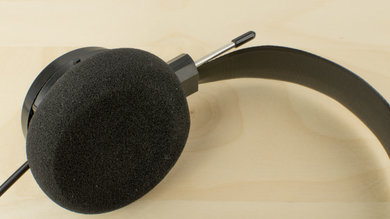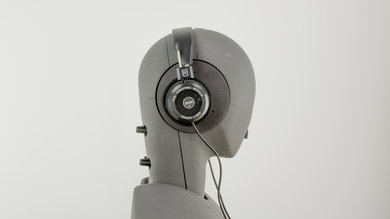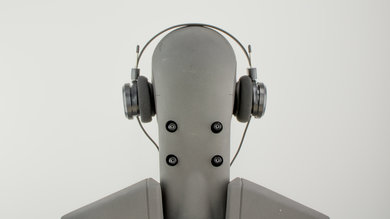The Grado SR80e/SR80 are decent open-back headphones for neutral sound but a below-average choice for everything else. They're decently comfortable and have a well-balanced mid-range and a good bass for an open-back design. Unfortunately, they have a mediocre-at-best build quality that doesn't feel very durable, and they sound a bit too piercing on already bright tracks. Also, because of their open-back design, they leak a lot and poorly isolate in noisy environments.
Our Verdict
Below-average for mixed usage. The Grado SR80e/SR80 are ideal for neutral sound, but they aren't really intended for other use cases. They deliver an above-average sound quality that reproduces instruments and vocals decently well but will sound a bit too sharp for some. They're also decently comfortable but are less stable than most on-ears and even some bulkier over-ear designs. They're also open-back headphones that won't be versatile enough for outdoor use by design.
-
Lightweight, comfortable on-ear design.
-
Above-average, open sound reproduction.
-
Very high leakage, by design.
-
No isolation from ambient noise, by design.
-
No audio controls.
The Grado SR80e are above-average neutral listening headphones. They have a wide, open soundstage and great reproduction of instruments and vocals. They lack a little bass and sound slightly sharp at times, but they reproduce the detail in high-res audio with above-average accuracy.
The Grado SR80e aren't designed for commuting. They don't block any ambient noise, which won't be ideal for a busy train or bus ride.
The Grado SR80e aren't intended for sports. They're unstable and the thick cable is bothersome. They also have no control scheme and are bit bulky and cumbersome to carry around on your person. On the upside, they're fairly breathable.
The Grado SR80e are sub-par for office use. Unless you work alone or in an isolated office, the leakage level will be too bothersome for those around you. Also, the open back design doesn't block any noise so you hear your environment fairly easily even when listening to music at higher-than-average volumes.
The Grado SR80e are below average for gaming. They're decently comfortable, sound great, and have a low latency wired design. However, they don't have a microphone for voice chat when gaming and no customization options, which are typical for most gaming headsets. Also, they don't have the convenience of wireless design or multiple connection options for an optimized experience on Xbox One or PS4.
- 5.2 Mixed Usage
- 7.7 Neutral Sound
- 4.2 Commute/Travel
- 5.3 Sports/Fitness
- 4.8 Office
- 4.5 Wireless Gaming
- 6.3 Wired Gaming
- 1.6 Phone Call
Changelog
- Updated Nov 21, 2019: Converted to Test Bench 1.3.1.
- Updated Nov 21, 2019: Converted to Test Bench 1.3.
- Updated Feb 16, 2018: Converted to Test Bench 1.2.
- Updated Aug 10, 2017: Converted to Test Bench 1.1.
- Updated Mar 01, 2017: Converted to Test Bench 1.0.
Compared To Other Headphones

The Grado SR80e have an above-average and open sound quality but lack many features for everyday, casual use. They're lightweight and moderately comfortable. The open-back design of the ear cups also improves their overall sound quality. Unfortunately, their build quality doesn't feel durable, and they fall off your head quite easily since they don't have the most stable design and have a bulky non-detachable stereo cable. They also have sharp and piercing sound quality that won't be ideal for all tracks, especially bright and treble-heavy songs. See our recommendations for the best on-ear headphones, the best headphones under $100, and the best audiophile headphones.
The Grado SR80e/SR80 have no significant differences when compared to the Grado SR60e/SR60. They sound about the same, although the SR80 have slightly better imaging and treble mostly due to better consistency in the treble range. However, like the SR60e, they sound sharp. This won't be for everyone, especially on already bright tracks. On the other hand, SR60e are a slightly better value for your money since they have the same performance and overall build quality as the SR80e.
The Grado SR80e/SR80 are pretty much identical to the Grado SR125e/SR125. The SR125e have slightly thicker and more durable cables, but have the same design and build quality as the rest of the budget Grado line up. The SR80 are, therefore, a better value for your money since they have the same performance at a cheaper price point. They also do a bit better in the treble range, although both headphones are a bit too sharp and may sound piercing on already bright tracks. Also, the difference in the treble is within the margin of error for our sound test, since its consistency varies from person to person.
The Grado SR80e/SR80 and the Grado The Hemp Headphone are both on-ear headphones that have slightly different advantages. While they have similar designs, the SR80e/SR80 are more comfortable. For the most part, they're able to produce more bass, although it's still somewhat underemphasized. Unlike the Hemp, their treble is also overemphasized, which makes them sound piercing and sharp. However, the Hemp have a better passive soundstage. They also feel better built.
The Grado SR225e/SR225 are also almost identical to the budget Grado SR80e/SR80 but have slightly different pads. The different pads emulate an over-ear design, but it's not very large, which means they still sit on the ears like on-ear headphones. On the upside, the SR80 are a better value for your money since they sound basically identical to the SR225e, except for the slightly better distortion performance of the more premium model. The SR80e are also a bit less cumbersome to carry around since their cable is not as thick and bulky.
The Koss Porta Pro KTC are slightly better headphones than the Grado SR80e/SR80. The Grado have a better build quality and a more open sound for critical listening with a larger soundstage than the Koss. The Koss, on the other hand, have a more outdoor-friendly design despite being open thanks to their portable on-ear format and in-line remote if you get the KTC variant. They also deliver more bass than the Grado, which some listeners will prefer, and they are compact enough to carry around on your person without much hassle, unlike the Grado.
Test Results
The Grado SR80e have a similar look to the Grado SR60e/SR60. They have the same distinct retro aesthetic with an all-black color scheme. Their style may not be for everyone, but they do stand out from other on-ear headphones. Unfortunately, the plastic used for the ear cups looks a little cheap. If you're looking for a pair of Grado on-ear headphones that stand out from the crowd, check out the Grado The Hemp Headphone.
The Grado SR80e deliver a decent comfort level. They're lightweight and don't feel too tight on your head for an on-ear design. Unfortunately, the cushion-like cover on the earpads doesn't feel good on the skin and is very susceptible to wear and tear. The headband is also not padded, but since they're very lightweight headphones, it's not much of an issue.
These headphones don't have any in-line controls.
The Grado SR80e are very breathable headphones. They have small on-ear cups that are open back, so they don't obstruct a lot of airflow. They also have slightly more breathable pads than typical on-ear designs, with pleather padding, which makes them even more breathable. For a more breathable pair of on-ear headphones, check out the Koss Porta Pro Wireless.
The Grado SR80e share the same design as the Grado SR60e/SR60. They're moderately portable and have a thin headband that's not too bulky. The ear cups lay flat to take up less space, and they will easily fit in a backpack. Sadly, they don't fold up into a more compact format, and the thick cable is a bit bothersome.
Like the Grado SR60, the Grado SR80e have a subpar build quality. They're lightweight and sufficiently dense to handle a few drops without damage but unfortunately, they feel cheap, and their plastic joints don't feel durable. They look poorly glued together, and the cushion-like material used for the padding is very susceptible to wear and tear. On the upside, they have few moving parts that are likely to become loose over time, and the thick audio cable looks tough.
These headphones are not designed for sports use. They have a long, thick, and non-detachable cable that easily gets tangled or hooked on something, which yanks the headphones off your head. They also have large ear cups and don't apply much pressure to the ears for the sake of comfort, which makes these headphones sway during any physical activity. They will quickly fall off your head while running and barely stay in place during casual listening sessions.
The Grado SR80's frequency response consistency is great. They show excellent bass delivery across multiple users and re-seats, which is most likely due to their open-back design. They also have a very consistent treble delivery, which is probably due to their on-ear design. Overall, they provide the same bass and treble response across multiple users and re-seats, regardless of the shape and size of your head and whether you wear glasses or not.
The bass is good. The LFE (low-frequency extension) is at 51Hz, which is decent. Additionally, low-bass, which is responsible for the thump and rumble common to bass-heavy music and sound effects, is lacking by 6dB. However, mid-bass, responsible for body and punch of bass guitars and kick drums, and high-bass, responsible for warmth, are within 1dB of our neutral target. Overall, the Grado SR80e's bass lacks thump and sub-bass but has just the right amount of body and punch.
The mid-range is great. The response throughout the range is virtually flat and very even. This results in a clear and well-balanced reproduction of the fundamental and lower harmonics of vocals and lead instruments. However, the 10dB bump around 2kHz brings excess intensity to upper harmonics of vocals and leads, making their overall mid-range noticeably forward.
The treble performance is average. The overall response is rather uneven and noticeably overemphasized throughout the range. Low-treble shows the continuation of the high-mid bump and is over our neutral target by about 4dB. This makes these headphones noticeably intense and bright sounding. Mid-treble is overemphasized by more than 4dB, resulting in a sharp and sibilant sound. This will be mostly noticeable on vocals and cymbals, making their S and T sounds harsh and piercing.
The Grado SR80 have great imaging. Their weighted group delay is 0.24, which is very good. The graph also shows that the entire group delay is below our audibility threshold. This ensures a tight bass and a transparent treble reproduction. Additionally, the L/R drivers of our test unit were well-matched in amplitude, frequency, and phase response, which is important for the accurate placement and localization of objects (voices, instruments, video game effects) in the stereo image. However, these results are only valid for our test unit, and your experience may vary.
The Grado SR80e's soundstage is mediocre. Due to their on-ear design, they don't interact with the pinna and don't activate its resonances. That's why the PRTF response is basically a flat line. This results in a soundstage that is perceived as small and located inside the listener's head. However, their open-back design helps in creating a more open-sounding and immersive soundstage compared to closed-back headphones.
The Grado SR80e's isolation performance is poor. This is by design and typical of open-back headphones. Therefore, they don't provide any isolation in the bass and mid-ranges, letting in all the low rumbling noise of airplane and bus engines and the chatter of people around you. In the treble range, occupied by sharp sounds like S and Ts, they provide about 5dB of isolation, which is inadequate.
The leakage performance is poor. This is by design and due to their open-back design. A significant portion of their leakage is spread across both the mid and treble ranges, which is quite a broad range. The overall level of their leakage is very loud too. With the music at 100dB SPL, the leakage at one foot away averages at 64dB SPL and peaks at 81dB SPL, which is way above the averages noise floor of an office.
The Grado SR80e does not come with a microphone. For a wired headphone with a good in-line microphone, check out the Bose SoundTrue Around-Ear II, the Bose QuietComfort 25/QC25, or the Apple EarPods.
The Grado SR80e doesn't have any active components and don't require a battery.
These headphones don't have a microphone so the noise handling hasn't been tested.
These headphones don't have any active components and don't require a battery.
These headphones don't have a companion app.
These headphones are wired and don't have a Bluetooth connection. If you want a similar design in a wireless format the consider the Grado GW100 Wireless. The wired connection has negligible latency, which is suitable for gaming and home-theater use. Although the range may be a bigger issue for that use case since they have a relatively short cable for watching movies from your couch.
The Grado SR80e don't have a dock. If you need a headset with a dock that also has a wired connection for gaming or watching movies, then consider the SteelSeries Arctis 7 Wireless 2017.
Comments
Grado SR80e/SR80: Main Discussion
Let us know why you want us to review the product here, or encourage others to vote for this product.


























































































